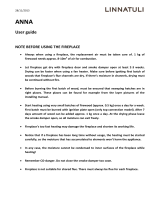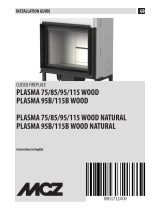HARVIA 10 Instructions For Installation And Use Manual
- Category
- Wood stove
- Type
- Instructions For Installation And Use Manual
This manual is also suitable for
HARVIA 10 is an iron stove designed to be safe and easy to use, while also looking good. It features a sturdy cast iron door with a vertical latching device, and an outer casing of painted steel. The heating chamber is made of cast iron protected by firebrick at the bottom. The extended flame channel in the top part of the heating chamber contributes to the efficiency of the hot plates in the iron stoves and makes the stoves excellent for heating room air.
The HARVIA 10 has excellent heat release properties, making it a good choice for heating a variety of spaces, such as homes and holiday houses. It is important to select the correct model for the size of the room, as burning too big a fire can lead to an excessive risk of fire and too high temperatures in fireplace structures.
HARVIA 10 is an iron stove designed to be safe and easy to use, while also looking good. It features a sturdy cast iron door with a vertical latching device, and an outer casing of painted steel. The heating chamber is made of cast iron protected by firebrick at the bottom. The extended flame channel in the top part of the heating chamber contributes to the efficiency of the hot plates in the iron stoves and makes the stoves excellent for heating room air.
The HARVIA 10 has excellent heat release properties, making it a good choice for heating a variety of spaces, such as homes and holiday houses. It is important to select the correct model for the size of the room, as burning too big a fire can lead to an excessive risk of fire and too high temperatures in fireplace structures.









-
 1
1
-
 2
2
-
 3
3
-
 4
4
-
 5
5
-
 6
6
-
 7
7
-
 8
8
-
 9
9
HARVIA 10 Instructions For Installation And Use Manual
- Category
- Wood stove
- Type
- Instructions For Installation And Use Manual
- This manual is also suitable for
HARVIA 10 is an iron stove designed to be safe and easy to use, while also looking good. It features a sturdy cast iron door with a vertical latching device, and an outer casing of painted steel. The heating chamber is made of cast iron protected by firebrick at the bottom. The extended flame channel in the top part of the heating chamber contributes to the efficiency of the hot plates in the iron stoves and makes the stoves excellent for heating room air.
The HARVIA 10 has excellent heat release properties, making it a good choice for heating a variety of spaces, such as homes and holiday houses. It is important to select the correct model for the size of the room, as burning too big a fire can lead to an excessive risk of fire and too high temperatures in fireplace structures.
Ask a question and I''ll find the answer in the document
Finding information in a document is now easier with AI
Other documents
-
Nordpeis Salzburg L Basic Fireplace stove User manual
-
Nordpeis PN-SAL03-00R Heat Retaining Stove Installation guide
-
Jøtul I 80 RH Installation And Operating Instructions Manual
-
 Linnatuli Anna User manual
Linnatuli Anna User manual
-
Hergom BENNINGTON User manual
-
Vermont Castings Defiant Encore 0028 Owner's manual
-
Vermont Castings Defiant 1945CE Homeowner's Installation And Operating Manual
-
 MCZ Forma Wood 95 Installation guide
MCZ Forma Wood 95 Installation guide
-
Vermont Castings Vigilant II 2310 Operating instructions
-
SCAN 5002 User manual










